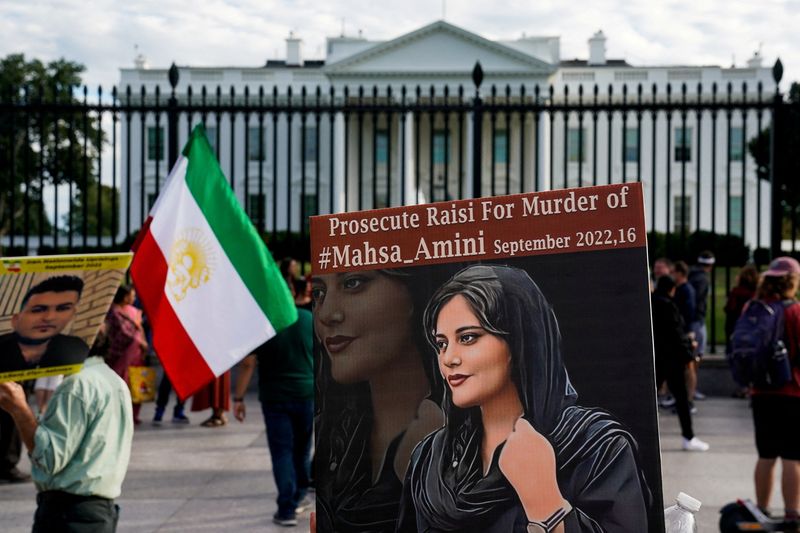Analysis-Beyond cutting hair and rhetoric, little West can do to change Iran’s trajectory
2022.10.20 04:17
[ad_1]
2/2

© Reuters. FILE PHOTO: Iranian Americans rally outside the White House in support of anti-regime protests in Iran following the death of Mahsa Amini, in Washington, U.S., September 24, 2022. REUTERS/Elizabeth Frantz/File Photo
2/2
By John Irish and Arshad Mohammed
PARIS/WASHINGTON (Reuters) – Western actors and officials have cut their hair on camera to dramatize their support for Iranian women whose protests have rocked the Islamic Republic since a 22-year-old woman died in the custody of Iran’s morality police over a month ago.
“For Freedom,” French actor Juliette Binoche said as she snipped off a hank of auburn hair in solidarity with Iranians decrying the death of Mahsa Amini, who was arrested on Sept. 13 in Tehran for “inappropriate attire” and died three days later.
Belgium’s foreign minister and two other lawmakers cut their hair in parliament.
The performances hint at a deeper reality: beyond voicing support, criticizing abuses and giving protesters digital tools to communicate, Western governments have few policy levers to influence events in Iran, officials and analysts said.
Four years of economic sanctions, reimposed by former U.S. President Donald Trump in 2018 and continued, if inconsistently enforced by his successor Joe Biden, have not stopped Iran’s expansion of its nuclear program, let alone curtailed its support for proxies abroad or crushing dissent at home.
In a world where oil prices have risen with the Ukraine war and where Iran’s major oil buyers, China and India, seem unfazed by the threat of stronger enforcement of U.S. sanctions, it seems that Tehran will continue to have a financial lifeline.
“In terms of economic tools that could really change the regime’s outlook … those tools are very limited,” said Henry Rome of the Washington Institute for Near East Policy think tank.
NO ‘REGIME CHANGE’ TALK
Given the unhappy results of U.S. interventions in Iraq and Afghanistan, there is no discussion of any U.S. effort to help topple an Iranian leadership itself born of a revolutionary rejection of an earlier U.S.-backed regime change in Tehran.
In 1953 the CIA helped orchestrate the overthrow of Iran’s popular Prime Minister Mohammed Mossadegh, restoring to power the Shah, Mohammed Reza Pahlavi, who was then ousted in the 1979 Islamic Revolution, heralding decades of U.S.-Iranian animus.
“We are not looking to get involved in regime change,” said a Western diplomat.
A U.S. official described Washington’s policy as three-fold: voicing support for protesters and their right to express their views; drawing attention to allegations against Iranian security forces of human rights abuses; and encouraging companies to preserve internet access in Iran, allowing demonstrators to communicate.
“The outcome is not going to be determined by what the U.S. does, by what the West does, by what any foreigner does, it’s going to be determined by what the Iranian people do and by what their government does in response,” the official said.
“We can shine a spotlight, we can make sure that the Iranian people know that they are not alone, that people are watching and that they are being heard. We can hold people who are repressing them accountable through our sanctions,” he added on condition of anonymity. “Those are the areas we are looking at.”
IRANIANS URGE WESTERN PRESSURE
Iran’s clerical rulers accuse the West of fomenting the protests. Iranians, inside and outside the country, have urged Western countries to pressure Iran by expelling its ambassadors and the family members of Iranian authorities who live abroad.
“The West doesn’t have too much leverage over Iran, but I think they must play their hands well,” said Saeid Golkar of the University of Tennessee at Chattanooga, also calling for imposing sanctions on Iranian plain clothes security forces.
Efforts to revive the 2015 Iran nuclear deal, hanging by a thread, have been made more difficult by Iran’s clampdown on the protests in which as many as 23 children have been killed by live ammunition, metal pellets at close range and beatings, according to the U.N. human rights office.
The suspected transfer of drones and possibly even short-range surface-to-surface missiles to Russia from Iran to help Russia in its war against Ukraine will also make Western leaders reluctant to push an accord that would give the Iranian government billions of dollars’ worth of extra resources.
Some officials and analysts argue Tehran may not seek a deal given the political sensitivities at home.
“If ever there was a time where having a nuclear deal would offer some level of economic relief, this would be the time to want it. However, if you do that you’re paving the way for your country for more openness and less isolation and that may be very difficult for the regime,” said the Western diplomat.
Even if Iran wanted to resurrect the pact, under which Tehran curbed its nuclear program in return for economic sanctions relief that raised its oil revenues, the crackdown makes it harder for Washington to cut a deal.
“The (U.S.) opponents of the deal would have more ammunition to attack a Biden administration that’s prepared to deal with a regime which, they might say, is on the ropes,” said Bob Einhorn of the Brookings Institution. “Why would we throw a lifeline to a regime that is on the ropes and that is killing young women?”
(Reporting John Irish in Paris and Arshad Mohammed in Washington; Additional reporting by Parisa Hafezi in Dubai; Editing by Mary Milliken and Grant McCool)
[ad_2]
Source link







